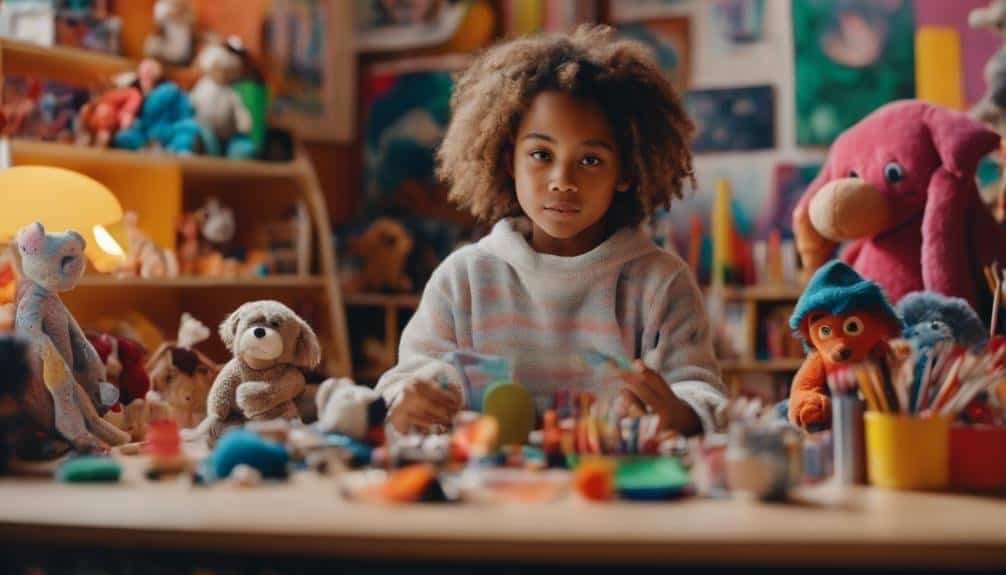Child Counseling: Techniques for Young Clients
In the domain of child counseling, employing a child-centered approach can be likened to laying the foundation for a sturdy house. However, as you navigate the intricate world of therapy with young clients, the techniques and strategies used must be as adaptable and diverse as the children themselves.
From the subtleties of play therapy to the profound impact of cognitive behavioral strategies, understanding the nuances of each method is essential.
So, how can these therapeutic tools be effectively wielded to guide children towards healing and growth?
Key Takeaways
- Utilize play therapy and art therapy for creative expression and emotional exploration.
- Foster trust and build strong therapeutic relationships through playful techniques.
- Develop coping skills, communication abilities, and self-esteem in young clients.
- Address trauma, family dynamics, and skill development for holistic child counseling.
Importance of Child-Centered Approach
Why is it important to adopt a child-centered approach in counseling young individuals?
It's essential to understand that children have unique needs and perspectives that must be considered in counseling sessions. By utilizing a child-centered approach, you can empower children to express themselves freely, build trust, and feel valued in the therapeutic process.
Empowering children is at the core of a child-centered approach. By focusing on the child's thoughts, feelings, and experiences, you create a safe space for them to explore their emotions and develop coping mechanisms. This approach helps children feel heard and understood, leading to more effective therapy outcomes.
Incorporating a child-centered approach means tailoring your counseling techniques to suit the individual child rather than using a one-size-fits-all method. By doing so, you can build a strong therapeutic alliance, enhance communication, and foster personal growth in young clients.
Utilizing Play Therapy Techniques
Hey there!
Let's talk about how important play therapy techniques can be when working with children.
Through play, kids can express themselves in ways they might find difficult with words.
Building trust through play creates a safe space for children to open up and work through their feelings.
Let's explore the power of using play as a tool for effective child counseling.
Importance of Play
In child counseling, the utilization of play therapy techniques is essential for fostering a safe and engaging environment where children can express themselves freely and work through their emotions.
Play therapy benefits young clients in numerous ways, such as promoting emotional expression, enhancing communication skills, building self-esteem, and facilitating problem-solving abilities.
Through play therapy techniques, children can explore their feelings and experiences in a non-threatening manner, allowing them to process complex emotions and develop coping strategies.
Expressing Through Play
To help children express themselves effectively, play therapy techniques offer a creative and engaging avenue for emotional exploration and growth. Play exploration allows young clients to communicate their feelings in a non-verbal manner, promoting creative expression.
Through play therapy, children engage in activities that aid in emotional processing, enabling them to make sense of their experiences and develop coping strategies. By incorporating toys, games, and art materials, therapists create a safe space where children can freely express themselves.
This form of therapy encourages imagination and problem-solving skills while fostering a sense of control and empowerment. Play therapy is a valuable tool in child counseling, providing a playful yet impactful method for young clients to navigate and understand their emotions.
Building Trust Through Play
Building trust with children through play involves creating a safe and nurturing environment where they can freely express themselves and develop a sense of security. Engaging in trust-building activities through explorative play can have a profound impact on the therapeutic process. Here are some techniques to help you foster trust and connection with your young clients:
- Puppet Play: Using puppets can help children externalize their thoughts and feelings.
- Sandplay Therapy: Allowing children to create stories in the sand promotes self-expression and exploration.
- Art Activities: Drawing, painting, or sculpting can be a non-verbal way for children to communicate their emotions.
- Role-Playing Games: Encouraging children to take on different roles can help them understand perspectives and build empathy.
Incorporating Art Therapy Methods
When incorporating art therapy methods into child counseling, encourage the use of various creative mediums to foster emotional expression and exploration. Creative expression through art can be a powerful tool in the healing process for young clients. By engaging in activities like drawing, painting, or sculpting, children can externalize their internal struggles and emotions, making them more tangible and easier to understand.
Visual storytelling is another effective technique within art therapy. Encouraging children to create visual narratives through their artwork can help them explore complex feelings and experiences in a safe and non-threatening way. This process allows them to communicate aspects of their inner world that may be difficult to articulate verbally, leading to deeper emotional exploration and insight.
Through art therapy, children can tap into their creativity and imagination to express themselves in ways that go beyond words. This can help them process difficult emotions, build self-esteem, and develop coping skills for managing challenges. By incorporating art therapy methods into child counseling, you're providing young clients with a unique and valuable outlet for self-expression and emotional growth.
Building Trust Through Therapeutic Relationship
Establishing a strong foundation of trust is essential in nurturing a therapeutic relationship with children undergoing counseling. When working with young clients, building trust through therapeutic techniques is critical for successful outcomes in child counseling. Here are some effective strategies to help you establish a strong bond with your young clients:
- Active Listening: Show genuine interest in what the child has to say and validate their feelings.
- Empathy and Understanding: Demonstrate empathy towards the child's experiences and emotions to create a safe space for them.
- Consistency and Reliability: Be dependable and consistent in your interactions to build a sense of security and trust.
- Respect Boundaries: Respect the child's boundaries and allow them to set the pace for sharing and opening up.
Implementing Cognitive Behavioral Strategies
Hey there! Let's chat about some cool stuff – Positive Self-Talk Techniques and Behavior Tracking Tools.
These strategies will help you understand your thoughts and actions better, making it easier to navigate tough situations.
Get ready to explore how these techniques can empower you to make positive changes!
Positive Self-Talk Techniques
Engage in positive self-talk techniques to cultivate a healthier mindset and enhance your cognitive behavioral strategies for personal growth and well-being. Here are some techniques to get you started:
- Positive Reinforcement: Encourage yourself with kind words and affirmations.
- Coping Skills: Develop strategies to manage stress and difficult emotions effectively.
- Creative Visualization: Imagine yourself succeeding and feeling confident in challenging situations.
- Mindfulness Exercises: Practice being present in the moment, observing your thoughts without judgment.
Behavior Tracking Tools
As you commence on exploring Behavior Tracking Tools to implement cognitive behavioral strategies, consider how these tools can empower you to monitor and modify your behaviors effectively for personal growth and positive change.
Behavior modification techniques are key in this process. Start by setting clear goals for the behaviors you wish to change or improve. Then, use tracking progress methods to monitor how you respond in different situations.
By observing your behaviors, you can identify patterns and triggers, enabling you to make informed decisions on how to modify them positively. Consistent behavior monitoring is essential for this technique to be effective.
Mindfulness and Relaxation Techniques
Exploring mindfulness and relaxation techniques can help children develop coping skills and manage stress more effectively. These techniques offer valuable tools for children to navigate their emotions and build resilience.
Here are some engaging methods to introduce mindfulness and relaxation to young clients:
- Breathing exercises: Teach children to take deep breaths in and out, focusing on the sensation of air filling their lungs.
- Guided imagery: Encourage children to imagine peaceful scenes or situations to promote relaxation and reduce anxiety.
- Progressive muscle relaxation: Guide children through tensing and relaxing different muscle groups to release physical tension.
- Sensory grounding techniques: Help children connect with the present moment by engaging their senses, such as touching a soft object or listening to calming music.
Encouraging Emotional Expression and Communication
Hey there! Ready to help kids express themselves and communicate better?
Let's get started with fun activities like identifying emotions, using art therapy, and playing games that encourage open communication.
Time to make counseling sessions engaging and effective for the little ones!
Emotion Identification Activities
Engage children in interactive games and exercises that help them recognize and express their emotions effectively. Here are some activities to assist in emotion identification:
- Emotion Charades: Act out different emotions for the child to guess and discuss.
- Feelings Bingo: Play a bingo game using emotion cards to match feelings with expressions.
- Emotion Wheel: Use a wheel with various emotions and scenarios to help children identify how they feel in different situations.
- Emotion Collage: Create a collage using pictures or drawings that represent different emotions, encouraging creative expression.
These activities promote emotion regulation and creative expression in a fun and engaging way.
Art Therapy for Kids
Using art as a medium, children can freely express their emotions and enhance communication skills in a supportive therapeutic environment. Creative exploration through art therapy allows kids to delve into their feelings without the pressure of words.
Through artistic expression, children can communicate complex emotions, fears, and joys in a non-verbal way, which can sometimes be easier for them to handle. Drawing, painting, or sculpting can reveal a world of unspoken thoughts and emotions, providing a safe outlet for self-expression.
Art therapy encourages kids to explore their inner world, fostering self-awareness and empowerment. By engaging in creative activities, children can develop new coping strategies, improve self-esteem, and learn to navigate their emotions more effectively.
Play-Based Communication Games
Encouraging emotional expression and communication in children can be effectively achieved through engaging play-based communication games. These playful communication techniques create a safe and fun environment for children to express their feelings and thoughts.
Through interactive therapy games, children can learn essential communication skills while enjoying the process. Child friendly communication strategies help build trust and rapport between the child and the counselor, fostering a positive therapeutic relationship.
Creative play interventions allow children to explore their emotions in a non-threatening way, promoting openness and self-expression. By incorporating these play-based communication games into counseling sessions, children can develop effective communication skills and gain confidence in expressing themselves.
Addressing Trauma Through EMDR
In addressing trauma through EMDR therapy, the focus is on guiding you through processing distressing memories to facilitate healing and resolution. EMDR, known for its effectiveness in trauma processing, utilizes bilateral stimulation to help your brain reprocess traumatic experiences in a less distressing way. During EMDR sessions, you'll be encouraged to recall specific memories while focusing on external stimuli like eye movements or taps. This process helps desensitize the distress associated with those memories, allowing you to create new, more positive associations.
As you engage in EMDR therapy, you may experience a range of emotions, which is completely normal. Remember, the goal is to work through these feelings to ultimately reduce the impact of past traumas on your present life. The therapist will support you throughout, ensuring you feel safe and empowered during the trauma processing. By actively participating in EMDR sessions, you're taking a significant step towards healing and finding resolution in your journey towards emotional well-being.
Family Therapy and Collaborative Interventions
Traversing through the journey of addressing trauma through EMDR therapy can lead to exploring collaborative interventions in family therapy, fostering a holistic approach to healing and growth.
When delving into family therapy and collaborative interventions, it's important to ponder the intricate web of family dynamics and the impact they have on a child's well-being.
By honing in on communication skills within the family unit, breakthroughs can be achieved, creating a supportive environment for the child's healing journey.
Here are some key points to keep in mind:
- Active Listening: Encouraging family members to actively listen to each other fosters understanding and empathy.
- Setting Boundaries: Establishing healthy boundaries within the family structure promotes a sense of safety and security for the child.
- Conflict Resolution: Teaching effective conflict resolution skills enhances communication and reduces tension within the family.
- Building Trust: Cultivating trust among family members creates a foundation for open and honest conversations, crucial for healing.
Supporting Parents and Caregivers in the Process
Supporting parents and caregivers through the healing process is a vital aspect of child counseling, nurturing a safe and understanding environment for both the child and those caring for them.
Parental involvement is key to the success of the child's therapy journey. By actively participating in sessions, parents can gain insights into their child's struggles and learn effective ways to support them outside of therapy sessions.
Acknowledging that caregivers also need support, providing caregivers with resources, coping strategies, and a space to express their own emotions can help them navigate the challenges they may face while caring for a child undergoing counseling.
Frequently Asked Questions
How Can Child Counselors Address Cultural Diversity and Sensitivity in Their Approach to Working With Young Clients?
In child counseling, addressing cultural diversity and sensitivity means understanding and respecting differences. Cultural competence and sensitivity training help you connect with young clients authentically, creating a safe space where they feel heard, valued, and understood.
What Are Some Strategies for Dealing With Challenging Behaviors and Resistance in Child Counseling Sessions?
When faced with challenging behaviors in child counseling, remember that behavior management and therapeutic techniques can be effective. Encourage parent involvement to track treatment progress and address resistance together. Stay patient and adaptable.
How Do Child Counselors Navigate Confidentiality and Privacy Issues When Working With Young Clients?
Handling confidentiality in child counseling is essential. Establish clear boundaries and address privacy concerns openly. Build trust through effective communication. Remember, fostering a safe space is key. Kids need to feel secure to open up.
What Role Do Parents and Caregivers Play in the Therapeutic Process, and How Can Counselors Effectively Involve Them in Treatment?
In therapy, parents and caregivers can be your partners. They bring insight, love, and support to the therapeutic process. Engaging them helps create a strong foundation for treatment, ensuring success and growth for all involved.
How Can Child Counselors Assess the Effectiveness of Their Interventions and Measure Progress in Therapy With Young Clients?
Wonder how your interventions impact young clients? Use outcome measures and progress tracking. Engage in therapeutic activities like play therapy to assess effectiveness. Watch progress unfold, guiding you in tailoring treatments for success.
Conclusion
As you guide young clients through child counseling, remember the power of play therapy, art therapy, and building trust in the therapeutic relationship.
Encouraging emotional expression and communication, addressing trauma through EMDR, and involving family therapy can make a significant impact.
By supporting parents and caregivers in the process, you create a holistic approach that nurtures growth and healing in children.
Remember, every small step you take can lead to big changes in their journey towards healing and happiness.







